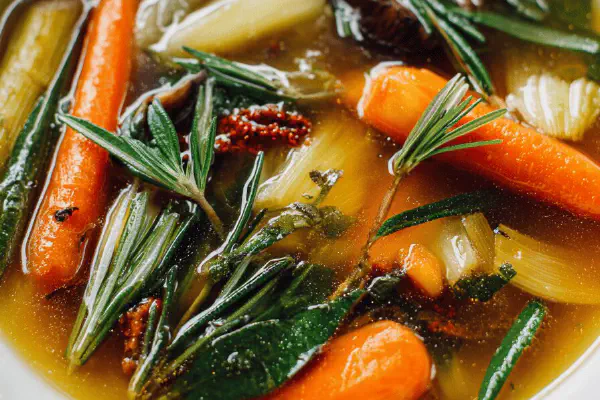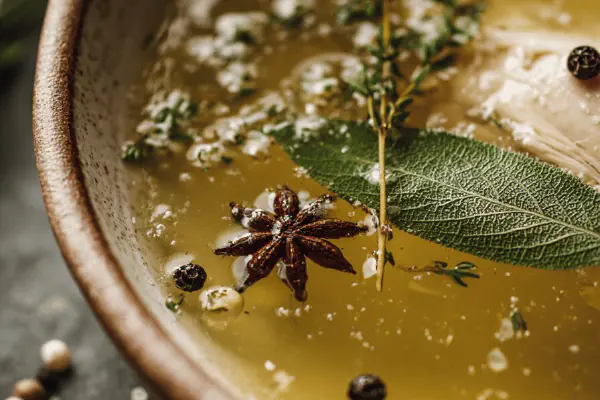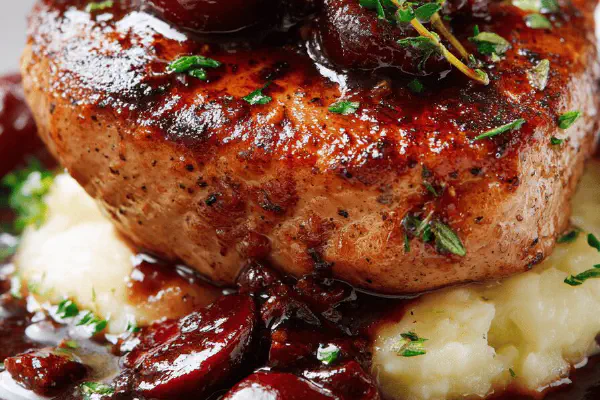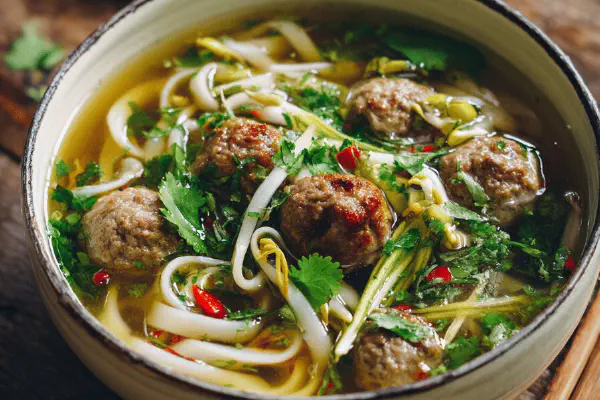Twisted Court-Bouillon
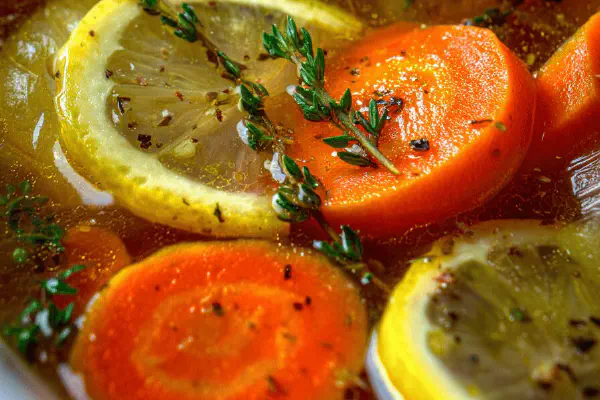
By Emma
Certified Culinary Professional
Ingredients
- 1 medium carrot peeled sliced into coins
- 1 small shallot halved thinly sliced
- 1 stalk celery trimmed thin half-moons
- 15 ml clarified butter or neutral oil
- 1 litre water
- 1 fresh thyme sprig
- 6 white peppercorns cracked lightly
- 3 dried bay leaves
- 1 lemon thinly sliced
- Optional 1/4 fennel bulb sliced thin (twist)
About the ingredients
Method
- Start with peeled carrot sliced thick—cannelure isn’t worth the fuss here, round is fine. Soft texture only matters at final simmer.
- Shallot, not onion; halved then sliced paper thin for subtle sweetness and less bite. Get finer cuts to avoid large chunks floating around.
- Celery rinsed thoroughly breaks up fibrous pieces; slice thin, half moons keep quick, even cooking.
- Heat clarified butter in a mid-size pot over medium heat; can sub vegetable oil if butter unavailable for higher smoke point. Melt until fragrant but not browned—takes about 1 minute. Watch closely; clarified butter burns easily, smells off when overheated.
- Toss in veggies; stir to coat with fat. You'll hear a faint sizzle but no color. Softening is key not caramelization here.
- Add sliced fennel if using—gives subtle licorice, I almost always forget but it brightens the broth.
- Pour water directly over vegetables; pour gently to avoid disturbing the aromatic bed.
- Add thyme sprig, bay leaves, cracked white peppercorns (sub white for a softer aroma and less sharp finish). White pepper often overlooked and better here for clean subtle spice.
- Turn heat to medium-high; bring to a 3-4 minute low boil. You want trembling surface bubbles not violent rolling boil which drives off flavor and dries out veggies.
- Watch for gentle fragrant steam; sharp herbal notes rise up here. If broth gets cloudy or veggies break apart—that's overcooking, reduce heat.
- Just before turning off, slide lemon slices on top of broth—no stirring. The citrus oils release instantly with residual heat. Easy mistake leaving lemon in too early; turns bitter.
- Turn off; cover and let sit 5-7 minutes to allow flavors to marry and veggies to infuse fully.
- Strain through fine sieve or cheesecloth, pressing lightly if you want concentrated flavor. Avoid pushing too hard—the broth will get murky.
- Taste: expect mild sweetness, fresh herbaceous notes, gentle pepper warmth, and bright lemon zest finish.
- Use immediately or refrigerate up to 2 days. Reheat gently to preserve delicate aromatics.
- For substitutions—no fresh thyme use 1/2 tsp dried but add earlier for flavor extraction. No fennel then add celery tops or parsley stems for fresh note.
- If broth tastes bitter, likely lemon was overcooked or herbs too old; fresh ingredients key here.
- For a dairy-free version use neutral oil instead of clarified butter but butter adds depth so opt for it when possible.
- Remember simmering time is flexible; watch for veggie translucency not strict minutes.
- Classic court-bouillon formulas use onion but replacing with shallot transforms flavor profile—softer, sweeter, less harsh.
- White peppercorns crack just before use for maximum aroma; whole peppercorns sit longer and lose punch.
- Carrot too thin equals mush; too thick slows infusion. Aim for uniform coin thickness as close to 1/4 inch as possible.
Cooking tips
Chef's notes
- 💡 Carrot thickness matters; aim for coins roughly quarter inch. Too thin leads to mush, too thick slows flavor release. Texture signals readiness. Look for softened but intact slices. Visual translucence beats clock timing here.
- 💡 Clarified butter heats fast, burns quick. Watch closely. Melt gently until just fragrant with no browning. Substitute neutral oil if smoke point needed higher. Don’t rush saute. Fat clarity impacts broth clarity too.
- 💡 White peppercorns cracked just before adding; releases oils without powder clouding broth. Black pepper oils can dull aromas. White gives soft but layered spice. Use sparingly for subtle warmth. Crack lightly for fresh scent.
- 💡 Add lemon slices only at the very end, no stirring. Heat residual in pot releases citrus oils without bitterness. Too early and broth turns sour. Look for bright yellow slices floating on top. Easy to miss timing here.
- 💡 Simmer at low boil not rolling. Surface bubbles trembling, not violent. Hot steam smells herbal, fresh. Cloudy broth means overcooked veggies; reduce heat if fibers break apart. Timing flexible—watch aroma and sight not minute counter.
Common questions
Can I swap shallots for onions?
Yes, but shallots bring sweetness less bite. Onion harsher flavor changes balance. Tried both many times. Shallots keep broth smooth, onions sharper edges. Depends on mood mostly.
What if butter burns?
Start over or add more oil. Clarified butter needs low medium heat. Watch color closely. Butter burnt smells off, bitter. Neutral oil backups work fine, flavor shifts slightly but avoids scorched taste.
How to store leftover broth?
Refrigerate max two days with lemon slices removed. Lemon bitterness grows cold storage. Freeze if longer. Reheat slowly, gentle heat stops aroma loss. Don’t boil again or broth dulls fast.
Why no black peppercorns?
Black oils overpower delicate herbs. White pepper softens, cleaner aroma. Tried black once, muddled broth notes badly. White cracked fresh yields subtle warmth under thyme and bay leaf.
Fennel optional, worth it?
Adds subtle anise lift, complexity if curious. Skip if fennel fresh not on hand. Celery tops or parsley stems can brighten but not replicate exact twist. Adjust to taste, experiment softly.
